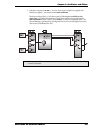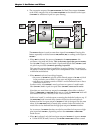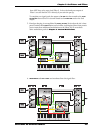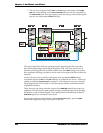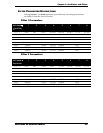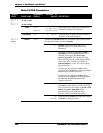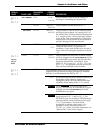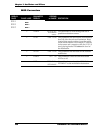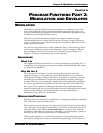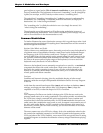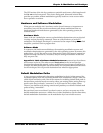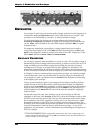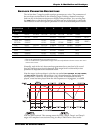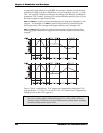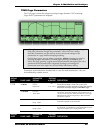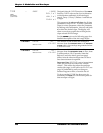
Chapter 6: Modulation and Envelopes
ANDROMEDA A6 REFERENCE MANUAL 131
CHAPTER 6
PROGRAM FUNCTIONS PART 2:
MODULATION AND ENVELOPES
MODULATION
Modulation is quite possibly the most-used operation in a synthesizer. It involves
more of the routine day-to-day synth functions than most people are aware of. In
fact, even the simplest of Programs has some kind of modulation programmed into
it. Otherwise, you wouldn’t be able to hear it.
This section will cover modulation principles and define a number of terms.
Understanding the basics as they are laid out here will make a world of difference
when you get to other topics that deal with specific modulations. Refer back to these
pages if you need a review.
Also, the A6 incorporates what is called a Modulation Matrix. This technology allows
you to route virtually any source to any destination, with few exceptions. Because
this functionality is fairly wide in scope, we’ve devoted an entire Chapter to it,
Chapter 9. The basics of modulation are covered right here.
BACKGROUND
What It Is
The simplest definition of modulation is “to change something by something else”. It
is modifying one component of a Program by another. Having said that, why would
we want to use modulation?
Why We Use It
As we discovered in Chapter 3, natural sounds go through many subtle but
significant changes as we are listening to them. Referring back to our example of
vibrating piano strings, all kinds of modulation is going on. A synthesizer provides
numerous types modulation to simulate the changes that an acoustic sound goes
through. Therefore, it is essential that a synthesizer provide modulation capabilities
if we are to approximate the subtleties and nuances of sounds we’re familiar with.
But a synth is also capable of producing modulations above and beyond what is
normally experienced with acoustically-produced sounds. Synthesizers have become
famous for their ability to emit sounds that have never been heard before.
Modulation has a whole lot to do with that.
MODULATION PRINCIPLES
Referring back to our definition of modulation as “changing something by something
else”, let’s take a look at what this means.
When a musical sound is played, it can start out loud and fade out. It can also fade in
and, at the peak of its loudness, end abruptly. It can fade in and then fade out, or just
start loud and end loud. This is volume modulation or, more precisely, amplitude
modulation. The loudness of the sound (“something”) can be changed by a pedal, an
envelope, an LFO, velocity or other sources (“something else”).
Still using this example, as a sound is being played, it can start out bright and full
and while it’s fading out in volume it’s also becoming less bright. Or as it fades in, it



